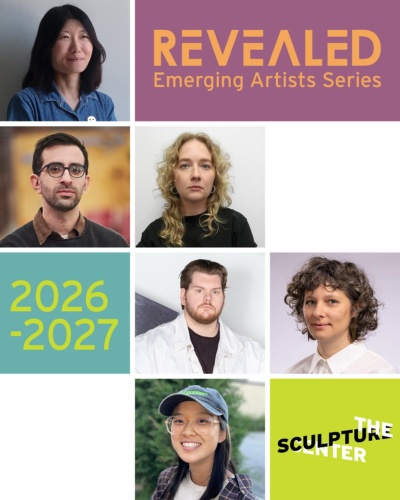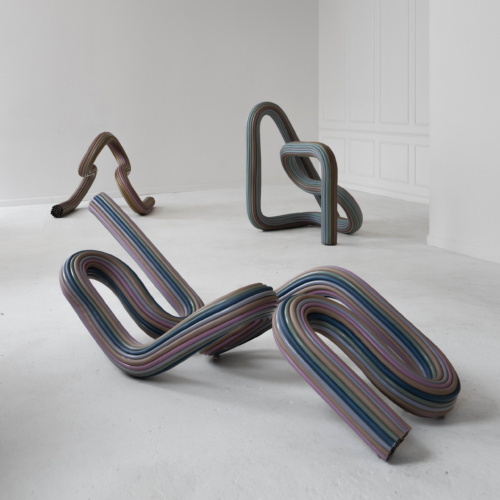Beverly Fishman Discusses Painting in DDEAF Magazine
Painting Artist-In-Residence Beverly Fishman discusses painting, pharmaceuticals and her art practice in the Spring issue of DDEAF Magazine.
By Kim Fay
Beverly Fishman
The formality and energy of an exhibition opening is lovely and entertaining. I usually hit it en masse to quickly view the work and catch up with friends. But it’s a studio visit, which unveils an artist’s process, I enjoy the most. Through sketched-out thoughts pinned to walls littered tabletops and floors, I can see ideas forming into a body of work. I also get to know the person behind the art, as artists discussing their work are revealing hidden corners of themselves. It may not be initially as clear as other forms of communicating, but it’s honest and a helluva lot more compelling and insightful.
Super-sized tablets, vibrantly colored, streamlined and glossy, demanded my attention the second I entered Beverly Fishman’s studio. Art is a vehicle to generate a sensation – peace, horror; high, low. These forms read stark and clinical. Beverly’s pills resemble regularly prescribed medications. Doctors brandish prescription pads as quickly as Western gunslingers their pistols. As the battle between the swollen pockets of Big Pharma and the American waistline expands. Her work is more relevant than ever. What about art contributing to healing? When I have a bad day, I run to the DIA to bask in the glow of a favorite painting. I always feel better after looking at it. Is it the more reverent environment, the image, or the combination that make just the right cocktail? If I stand in front of something that looks like Xanax, will it relieve my anxiety? If a man contemplates a pill that looks like Viagra, is his lover in for it later?
Acknowledgement may come quickly, but more likely from intensive effort. Beverly is passionately devoted to her practice as well as her role as mentor to other artists. IN relating her journey to freshly minted art makers, and those of us who’ve been around a bit, she delivers truth pills with no sugar coating to choke them down. Her disciplined time in the studio combined with dedication to her vision has resulted in success any artist dreams about. If you get up early morning and get to work, you can live your life as a working artist. A prescription taken as directed.
You said your work begins with the cell as a symbol of self. What does that mean?
That is how my work started in the late ‘80’s. I was interested in identity, and what it meant to an individual in my contemporary moment. I thus felt compelled to engage with my role as an artist during the AIDS crisis in NYC. Close friends and acquaintances were dying, ravaged and then destroyed by an “invisible” virus. I was not interested in what we looked like externally, but rather how we tested for HIV. I thought of cells and viruses as powerful components of the self. I have continued over several decades to return to the cell as a site for investigation.
How does disease, cure and placebo relate to your work?
In the late ‘80’s and ‘90’s I was interested in disease. I used cellular and biological images-Which I appropriated from medical texts with a color copier and then rendered more abstract—as forms through which to image new configurations of the self as a combination of genetic and biological elements. In the 2000s, I turned from disease to the “cure”—science and medicine. I created glowing resin pills that explored the pharmaceutical as an ideal, raising questions about our stereotypes of “sickness” and “health” “normal” and “abnormal”. I also made abstract modular paintings that envisioned human identity as a combination of scanned bodily readouts—molecules, helixes, EKG and EEG patterns, DNA codes, Neuron spike readouts, and sound waves—and morphed commercial elements, such as pharmaceuticals, circuit boards, bar codes, and QR codes. Although I believe that medicine and the pharmaceutical industry do much more good than harm, the more I researched, the more I became alarmed by the over-prescribing of medicines, the power of Big Pharma to expand and colonize ever-new areas of our bodies and minds. Recent research on “placebo effect” suggests that, like the ritual of medicine, colors and forms can affect us on a physiological level, helping us to heal and prosper. Thus the formal elements of painting can affect us like a drug; and the drug industry should become more open to other avenues of healing.
Despite some visual alterations, your pills are immediately identifiable if you take them. You’ve said what you take is part of your identity. Can you explain that relationship?
The pharmaceuticals in my work often remain identifiable because I want the viewer to be personally engaged. If you identify a form as Valium, or Klonopin, or Viagra, or Fosamax, then you might see my work as speaking to you directly: saying something about your inner, rather than your outer self. I want my work to undermine the notion that “biology is destine”. Biology is not destine because we are constantly tweaking and changing our natures through what we eat, what we buy and how we medicate ourselves.
Regarding women in art: How are we doing? Do we still need voices like Guerrilla Girls? Who were you mentors and how did they impact you and your work?
If you look at the statistics, women do not do as well as men in the art world. In art schools, there are far more women than men, yet when you look at the exhibition record in major art centers like New York and Los Angeles, men far outnumber women. Women are just as brilliant artists as men, but until we have the same opportunities, we still need the Guerilla Girls, as well as more women—and more supportive men—in all areas of the art world. I was very lucky to have worked with the feminist artist Ree Morton in my undergraduate program at Philadelphia College of Art. She made a lasting impression on me. Then, while doing my MFA at Yale, I met Judy Pfaff and Elizabeth Murray. I was blown away by the power and importance of their work, and their example showed me that anything was possible if you just channeled your ambition into your work.
There are many myths and fantasies about what a working artist’s life looks like. What’s your reality?
I get up early and I work every day, balancing my own artistic practice and research in the studio with mentoring 15 graduate students at Cranbrook Academy of Art. I also work hard on my business side of my art, and despite what is basically doing three full time jobs simultaneously, I also try to have a personal life with my wonderful husband. This, needless to say, is a challenging juggling act, and there seems never to be enough time for my own studio practice.
What’s the overall message you’re trying to get across?
My most recent series of works are polychrome reliefs that I paint with urethane automobile colors. They explore the phenomenology of spectatorship in the context of painting’s history, as well as the concrete historical conditions that undergird the multi-billion dollar global drug production industry. The work employs scale shifts and chromatic juxtapositions to turn tiny commodities into large signs and corporate logos that promise health, beauty, pleasure and the transcendence of death. Through this series, I hope to explore our contemporary global condition in which drugs construct and contest identity. But I am also interested in the long history of painting—painting as a sign, color, painting and technology, fetish finish, object, etc.,– in short, painting’s long history as both an abstract and a representational practice.
Anything else you’d like to add?
I wish I had more time in the day and more energy to get everything I want accomplished!


